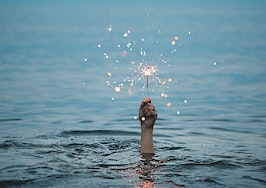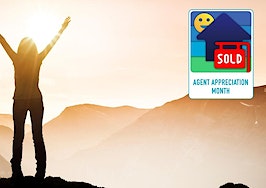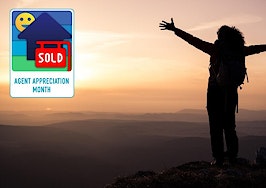You have just taken a new listing, and you plan on staging the house and ordering professional photos, drone photography and a 360-degree virtual tour. A new research study from HomeJab examining how agents use professional photographers found that less than half the properties are well-prepared when the photographer arrives on photoshoot day.
I recently interviewed Joe Jesuele, the CEO and founder of HomeJab, a company that provides on-demand professional real estate photography, virtual staging and aerial photography. It recently released two studies about how agents use professional photography to market their listings as well as what professional photographers thought about the agents who hired them.
Why use professional photography?
Virtually all top agents use professional photography to show their listings to their best advantage and to demonstrate how they market their listings during listing appointments.
To illustrate the power of professional photography, which of these two houses would you show first?


These photos are pictures of the same property. The first photo is the one that appears on Google maps. The second photo was taken by a professional photographer at twilight.
5 key findings from the HomeJab research
Based on their study of approximately 300 agents, here are their key findings:
- Seventy-two percent always hire a professional photographer, 15 percent do so if the property is over a certain price point, while only 2 percent use professional photography based upon a client request.
- In terms of the types of virtual tours that agents preferred most, 21 percent preferred 3D/360 tours, 35 percent preferred video walk-throughs and 31 percent liked both types equally.
- Top agents post copious numbers of listing photos. HomeJab’s statistics show 51 percent post at least 30 pictures, 19 percent post at least 40, 5 percent post at least 50, and another 5 percent post over 50.
- In terms of popularity, virtual staging just surpassed traditional staging by a small margin. Reasons include that virtual staging can be done quickly, you can select whatever furniture you want, and it’s much less expensive than renting furniture.
- Twilight photos produce three times more engagement than regular photos.
12 tips to optimize your real estate photos and impress potential buyers
Jesuele recommends beginning with the exterior first.
Preparing the exterior
1. Choose gray, overcast days for your photoshoot
According to Jesuele, sunny days create glare and shadows. In contrast, cloudy days are not only ideal but a “godsend” for capturing stunning real estate images:
“Cloudy days allow for more balanced lighting throughout your home, especially with window shots. When the lighting is balanced, capturing a lovely kitchen or living room with wide windows and a panoramic view becomes much easier.”
If you’re concerned about your outdoor photographs appearing drab, the photo editor can easily add a touch of blue sky in post-production to make it look like a perfectly sunny day.
2. Schedule your photoshoots in the morning
Jesuele says only a few hours in the morning are ideal for your photoshoot. Consequently, schedule early, and be finished no later than noon. In other words, “Morning shadows are your besties and afternoon shadows should be avoided full stop.”
This advice also applies if you’re doing a virtual walk-through on one of your listings using Zoom or one of the streaming apps. Again, a cloudy day or the early morning sun yields the best results.
3. Avoid cars parked in the driveway or in front on the street
Many people park their cars in the driveway or live in an area where there is limited on-street parking. Advise your sellers to do everything possible to avoid having vehicles in their driveway or in front of their property the day of the photoshoot.
Because many places post no parking signs when they clean the streets, schedule the photoshoot at that time to avoid this problem.
4. Move garbage cans and recycling bins
Don’t expect the photographers to move trash cans, toys or anything else. Consequently, never schedule the photoshoot on trash pickup day. If that’s impossible, advise the sellers to skip putting out their trash that week.
That’s the best way to avoid having their trash cans become the focal point of their exterior photos. Remove any bicycles or other kids’ toys as well. As a rule of thumb, anything that is not attached or that is not a fixture should be removed before the photographer arrives.
5. Schedule a landscape crew the day before the photoshoot
This is especially important in the fall and winter when there are a lot of leaves and debris. The day before the photoshoot, have the landscape crew clean up the yard, mow if needed and remove any dead plants including those in flowerpots. (Dead flowers, by the way, are bad feng shui.)
If seasonal flowers are available in nice pots, place them on outdoor tables or anywhere else where they would improve the exterior shot.
6. Alert the neighbors ahead of drone photography
According to Jesuele, about a third of the photographers who do drone photography had issues with neighbors threatening them. Some even called the police.
Avoid alarming the neighbors by notifying them of the date and time of the drone photoshoot. You can do this by leaving a door hanger on the doors of any neighbors who may be impacted, door-knocking and explaining that you will have a professional photographer taking aerial shots of your listing and/or asking the sellers to spread the word to the neighbors.
Preparing the interior
If you have staged the property, you may have already addressed a number of these issues. When it comes to staging, however, the one day that matters most is the day of the photoshoot.
Here’s a list of what the sellers must do to prepare the interior of their home for the photoshoot.
7. Declutter and remove personal items
When it comes to staging, “less is more.” Decluttering makes the rooms look larger and more inviting. Counters and tables in all rooms should be cleared except for a few well-placed items such as a coffee pot in the kitchen, flowers on a table or simple decorating items. All toys must also be put away.
Remind the seller that they want buyers to picture themselves living in the home, not be confronted with how the present owners are living in the property. Consequently, have the sellers pack precious family photos and other personal items so they will be ready to be moved into their next home.
For sellers who refuse, BoxBrownie and HomeJab can “remove” items from the photos in post-production.
8. Shooting bathrooms — the most problematic room in the house
Did you know that many people from outside the U.S. are appalled to see toilets in listing photos, especially with the lid up? Equally unappealing is seeing all the owners’ personal cosmetics, shampoos, and other items in the shower, tub, or on the counters. All those throw rugs, especially around the toilet, are even worse.
Advise the seller to throw the rugs in the washer, put the lids down on the toilets and remove all personal grooming items from the tubs and showers on photoshoot day.
Also, ask the photographer to avoid shooting photos with the toilet in the picture unless there’s no other way to photograph the bathroom.
9. Dust hardwood floors and flat surfaces
According to Jesuele, while items can be removed from the photos, dust on the hardwood floors or countertops shows up clearly and cannot be removed in the photo editing process.
10. Working with pets — problematic at best
Pets must be crated or better yet, not in the house at all on photoshoot day. The photographer is not going to pick the cat up from the sofa to avoid having it in the photo.
Because so many people have allergies and are also aware of how much damage pets can do to a home, Jesuele recommends removing every possible sign that the owners have a pet on photoshoot day. In particular, the cat tree and the litterbox need to go. Again, don’t expect the photographer to move any of these items.
11. Don’t insist on photographing every room in the house
If the owners don’t have a place where they can remove items and safely put their pets out of sight, Jesuele says to lock the door to one of the rooms you don’t need to shoot and put all those items there.
12. Shooting vacant houses
While photographers love shooting vacant properties, empty rooms lose dimension. BoxBrownie is one example of an inexpensive way to virtually stage vacant properties as well as to obtain twilight photos at a minimal cost.
Jesuele’s final piece of advice is to think about the photographer and have everything prepared for the photoshoot so it’s efficient and everyone is happy.
Methodology
About The HomeJab Professional Real Estate Photographer Survey:
HomeJab collected responses from 310 professional real estate photographers nationwide. Fifty percent of the photographers surveyed shoot more than 100 property listings annually. Nearly one in three photographers surveyed shoot more than 200 property listings annually, with 40 percent of the participants being professional photographers for at least six years.
Bernice Ross, president and CEO of BrokerageUP and RealEstateCoach.com, is a national speaker, author and trainer with over 1,000 published articles. Learn about her broker/manager training programs designed for women, by women, at BrokerageUp.com and her new agent sales training at RealEstateCoach.com/newagent.








